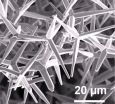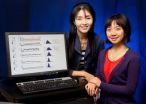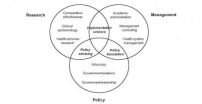(Press-News.org) The scientists of Kiel University, University of Erlangen-Nuremberg and the Technische Universität München (TUM) have published their results in the current issue of the journal Advanced Materials.
"The luminescent features of zinc oxide tetrapod crystals are well established. According to our work hypothesis, these characteristics showed pronounced variations under a mechanical load, and we realised that it could help to detect internal damages of composite materials", says Dr. Yogendra Mishra of Kiel University's Technical Faculty. In one experiment, the scientists added zinc oxide tetrapod shaped crystals to a silicone (polydimethylsiloxane) polymer and tested its general properties. They found that the resulting composite material is on the one hand stronger than silicon and on the other hand emits light in different colors when exposed to UV light. When the material is subjected to mechanical stress, the intensities of the emitted lights changes.
"The micro-nano sized crystals give a visual warning when the composite material is about to fail under stress", explains PhD student Xin Jin. "The alteration of the luminescent characteristics of defined semiconductor microstructures under load – as we could show for zinc oxide tetrapods – might be also interesting of many other phosphor material systems", adds Professor Cordt Zollfrank who leads the research area 'biogeneous polymers' at TUM. "We expect further interesting developments in this emerging field on "self-reporting materials".
Composite polymer materials are used in diverse fields from dental implants to spacecrafts. They are made from two or more constituent materials with different properties such as silicone and zinc oxide crystals which together render better properties. On demands, they can be designed to be light-weight, mechanically robust and still inexpensive. Professor Rainer Adelung, leader of the study, says: "Zinc oxide crystals seem to be an excellent component to design numerous specific composite materials – also for constructions in which stability is critical to life."
INFORMATION:
Original publication:
Xin Jin, Michael Götz, Sebastian Wille, Yogendra Kumar Mishra, Rainer Adelung, Cordt Zollfrank (2012): A novel concept for self-reporting materials: Stress sensitive photoluminescence in ZnO tetrapod filled elastomers, Advanced Materials, doi: adma.201203849
The study was funded by the German Research Foundation (DFG) within the Collaborative Research Centers 677 and 855.
Contact:
Prof. Dr. Rainer Adelung
Kiel University, Germany
phone: +49 431 880-6116
e-Mail: ra@tf.uni-kiel.de
Prof. Dr Cordt Zollfrank
Technical University Munich, Germany
phone: +49 9421 187-450
e-mail: cordt.zollfrank@tum.de
http://www.wz-straubing.de/
Predicting material fatigue
Nanocrystals reveal damaged material
2012-11-30
ELSE PRESS RELEASES FROM THIS DATE:
Young surgeons face special concerns with operating room distractions
2012-11-30
CORVALLIS, Ore. – A study has found that young, less-experienced surgeons made major surgical mistakes almost half the time during a "simulated" gall bladder removal when they were distracted by noises, questions, conversation or other commotion in the operating room.
In this analysis, eight out of 18, or 44 percent of surgical residents made serious errors, particularly when they were being tested in the afternoon. By comparison, only one surgeon made a mistake when there were no distractions.
Exercises such as this in what scientists call "human factors engineering" ...
A human-caused climate change signal emerges from the noise
2012-11-30
Livermore, Calif. -- By comparing simulations from 20 different computer models to satellite observations, Lawrence Livermore climate scientists and colleagues from 16 other organizations have found that tropospheric and stratospheric temperature changes are clearly related to human activities.
The team looked at geographical patterns of atmospheric temperature change over the period of satellite observations. The team's goal of the study was to determine whether previous findings of a "discernible human influence" on tropospheric and stratospheric temperature were sensitive ...
Delayed treatment for advanced breast cancer has 'profound effect'
2012-11-30
COLUMBUS, Ohio – Results from a new study conducted by researchers at The Ohio State University Comprehensive Cancer Center – Arthur G. James Cancer Hospital and Richard J. Solove Research Institute (OSUCCC-James) show women who wait more than 60 days to begin treatment for advanced breast cancer face significantly higher risks of dying than women who start therapy shortly after diagnosis.
"We wanted to see whether delaying treatment affected mortality rates among women with breast cancer," says Electra D. Paskett, associate director for population sciences at OSUCCC-James. ...
Diabetics with cancer dangerously ignore blood sugar
2012-11-30
CHICAGO --- When people with Type 2 diabetes are diagnosed with cancer -- a disease for which they are at higher risk -- they ignore their diabetes care to focus on cancer treatment, according to new Northwestern Medicine® research. But uncontrolled high blood sugar is more likely to kill them and impairs their immune system's ability to fight cancer.
However, people with Type 2 diabetes who received diabetes education after a cancer diagnosis were more likely to take care of their blood sugar. As a result, they had fewer visits to the emergency room, fewer hospital admissions, ...
Autism severity may stem from fear
2012-11-30
Most people know when to be afraid and when it's ok to calm down.
But new research on autism shows that children with the diagnosis struggle to let go of old, outdated fears. Even more significantly, the Brigham Young University study found that this rigid fearfulness is linked to the severity of classic symptoms of autism, such as repeated movements and resistance to change.
For parents and others who work with children diagnosed with autism, the new research highlights the need to help children make emotional transitions – particularly when dealing with their fears.
"People ...
Can life emerge on planets around cooling stars?
2012-11-30
Astronomers find planets in strange places and wonder if they might support life. One such place would be in orbit around a white or brown dwarf. While neither is a star like the sun, both glow and so could be orbited by planets with the right ingredients for life.
No terrestrial, or Earth-like planets have yet been confirmed orbiting white or brown dwarfs, but there is no reason to assume they don't exist. However, new research by Rory Barnes of the University of Washington and René Heller of Germany's Leibniz Institute for Astrophysics Potsdam hints that planets orbiting ...
Working couples face greater odds of intimate partner violence
2012-11-30
HUNTSVILLE, TX (11/30/12) -- Intimate partner violence is two times more likely to occur in two income households, compared to those where only one partner works, a recent study at Sam Houston State University found.
The study, conducted by Cortney A. Franklin and Tasha A. Menaker and supported by the Crime Victims' Institute, was titled, "Differences in Education/Employment Status and Intimate Partner Victimization." It looked at the impact of education levels and employment status differences among heterosexual partners on intimate partner victimization. While differences ...
Proteins that work at the ends of DNA could provide cancer insight
2012-11-30
CHAMPAIGN, lll. — New insights into a protein complex that regulates the very tips of chromosomes could improve methods of screening anti-cancer drugs.
Led by bioengineering professor Sua Myong, the research group's findings are published in the journal Structure.
Myong's group focused on understanding the proteins that protect and regulate telomeres, segments of repeating DNA units that cap the ends of chromosomes. Telomeres protect the important gene-coding sections of DNA from loss or damage, the genetic equivalent of aglets – the covering at the tips of shoelaces ...
Defining career paths in health systems improvement
2012-11-30
The sheer number of efforts aimed at improving the quality and efficiency of the U.S. health care system – ranging from portions of the national Affordable Care Act to local programs at individual hospitals and practices – reflects the urgency and importance of the task. One aspect that has received inadequate attention, according to three physicians writing in the January 2013 issue of Academic Medicine, is training the next generation of experts needed to help lead these efforts. In their Perspective article, which has been released online, the authors propose a framework ...
More evidence for an ancient Grand Canyon
2012-11-30
PASADENA, Calif.—For over 150 years, geologists have debated how and when one of the most dramatic features on our planet—the Grand Canyon—was formed. New data unearthed by researchers at the California Institute of Technology (Caltech) builds support for the idea that conventional models, which say the enormous ravine is 5 to 6 million years old, are way off.
In fact, the Caltech research points to a Grand Canyon that is many millions of years older than previously thought, says Kenneth A. Farley, Keck Foundation Professor of Geochemistry at Caltech and coauthor of the ...
LAST 30 PRESS RELEASES:
Why nail-biting, procrastination and other self-sabotaging behaviors are rooted in survival instincts
Regional variations in mechanical properties of porcine leptomeninges
Artificial empathy in therapy and healthcare: advancements in interpersonal interaction technologies
Why some brains switch gears more efficiently than others
UVA’s Jundong Li wins ICDM’S 2025 Tao Li Award for data mining, machine learning
UVA’s low-power, high-performance computer power player Mircea Stan earns National Academy of Inventors fellowship
Not playing by the rules: USU researcher explores filamentous algae dynamics in rivers
Do our body clocks influence our risk of dementia?
Anthropologists offer new evidence of bipedalism in long-debated fossil discovery
Safer receipt paper from wood
Dosage-sensitive genes suggest no whole-genome duplications in ancestral angiosperm
First ancient human herpesvirus genomes document their deep history with humans
Why Some Bacteria Survive Antibiotics and How to Stop Them - New study reveals that bacteria can survive antibiotic treatment through two fundamentally different “shutdown modes”
UCLA study links scar healing to dangerous placenta condition
CHANGE-seq-BE finds off-target changes in the genome from base editors
The Journal of Nuclear Medicine Ahead-of-Print Tip Sheet: January 2, 2026
Delayed or absent first dose of measles, mumps, and rubella vaccination
Trends in US preterm birth rates by household income and race and ethnicity
Study identifies potential biomarker linked to progression and brain inflammation in multiple sclerosis
Many mothers in Norway do not show up for postnatal check-ups
Researchers want to find out why quick clay is so unstable
Superradiant spins show teamwork at the quantum scale
Cleveland Clinic Research links tumor bacteria to immunotherapy resistance in head and neck cancer
First Editorial of 2026: Resisting AI slop
Joint ground- and space-based observations reveal Saturn-mass rogue planet
Inheritable genetic variant offers protection against blood cancer risk and progression
Pigs settled Pacific islands alongside early human voyagers
A Coral reef’s daily pulse reshapes microbes in surrounding waters
EAST Tokamak experiments exceed plasma density limit, offering new approach to fusion ignition
Groundbreaking discovery reveals Africa’s oldest cremation pyre and complex ritual practices
[Press-News.org] Predicting material fatigueNanocrystals reveal damaged material


